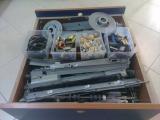
|
 Home Home
 Projects Projects
 Experiments Experiments
 Circuits Circuits
 Theory Theory
 BLOG BLOG
 PIC Tutorials PIC Tutorials
 Time for Science Time for Science
|
| ||
Some time ago I uploaded a video explaining how one can remove the various components from an old PCB fast and easy. The purpose of this video was to encourage people to salvage parts from old electronic and electrical appliances for educational purposes. Even if your warehouse is empty, you can find lots of electronics at your local bazaars. I visit the Sunday bazaar in my country quite often and search for hidden treasures. A 386 PC, an old and busted photo-copier, a hair dryer, a small oven... Most people think that these are trash to be dumped or recycled. But a creative person will have a different opinion. Obviously, lots of people misunderstood the purpose of this video. Many thought that the purpose is to save money by reusing the resistors and the capacitors from heavily used PCBs.. That is not the case. Obviously used electrolytic capacitors have little or no life left But having a bin of parts like solenoids, connectors, toroidal inductors, motors, stand-offs, knobs, rods, pulleys, small bearings and other mechanical parts is a great resource to make new projects. One benefit from salvaging PCBs is that you can gain experience from the professionals. Electronic Engineers have worked hard to find solutions and put things together into a PCB that works for commercial products. You can reverse-engineer the PCB, recreate the schematic and discover ingenious signal and power filtering solutions, interfaces and clever parts usage. Then you can create a new PCB or prototype on a breadboard since you have all the parts, let it run, probe its output, use different parts and earn tons of experience. I was given once a photo-copier machine. It was out of order and heavily used in an office for years. Before dumping it into the junk yard, I removed each and every part from inside. It took me more than 12 hours to finish. I got tens of different stepper motors, four beautiful and fully functional mini air pumps used for the toner, two IR heater lamps, a load of mechanical parts such as rods, gears, rubber wheels, pulleys, bearings and bushes that all work together, tens of extremely sensitive switches, IR couples and many other parts.  Gears, pulleys, toothed belts, bushes, rods, guides, solenoids... All salvaged from one photo copier Second win: Since there were lots of different motors inside, I wanted to discover how they were controlled. I discovered several different embedded chips used, such as the STK672 series stepper motor driver. Immediately I salvaged all of them and began fooling around. I had everything in hands, the motors, the controllers, the filters, even the wires and the connectors (tons of wires actually and connectors). I downloaded the datasheets, did some research, prototyped a few circuits and shortly I had designed my own stepper motor controllers which all worked like charm (and literally for free). So, second win is the Experience! And third win: Every now and then I search around my warehouse for “ideas”. One day I came across these beautiful IR heater lamps salvaged from this photo-copier. When I saw them, an idea popped into my mind: An acrylic glass folding heater! I designed a TRIAC dimmer for the lamp and I had myself an expensive acrylic glass folding heater able to bend 12mm thick acrylic glass (since the lamps were very powerful). Third win: Creativity! Bottom line is that salvaging parts from old and busted machines has little to do with the economical profit. One may of course sell the bare PCBs and the chips for recycle (copper, gold and other metals). But at the end of the day you will have gain more than the parts themselves: Motive - Experience - Creativity  Continue reading. Click here to view the references. Continue reading. Click here to view the references.Comments
|
|
 Contact Contact
 Forum Forum
 Projects Projects
 Experiments Experiments
 Circuits Circuits
 Theory Theory
 BLOG BLOG
 PIC Tutorials PIC Tutorials
 Time for Science Time for Science
 RSS RSS
Site design: Giorgos Lazaridis © Copyright 2008 Please read the Terms of services and the Privacy policy |